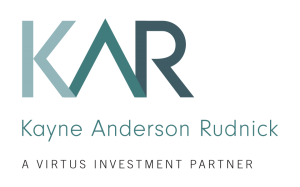
Jon Christensen
Portfolio Manager and Senior Research Analyst
Kayne Anderson Rudnick
KAR portfolio manager Jon Christensen discusses mid-cap equity performance in the first quarter, the largest stock contributors and detractors in the KAR Mid Cap Core strategy, and expectations for earnings growth.
Listen Now
Transcript
BEN FALCONE: Hello, this is Ben Falcone, managing director with Kayne Anderson Rudnick, and with me today, I have Jon Christensen, portfolio manager of the KAR Mid-Cap Core strategy. Welcome, Jon.
Jon, market returns were broadly positive again in the first quarter, even though many issues such as clarity on Fed movements, geopolitical risk, upcoming presidential election, although heavily debated, still remain. Amidst the talk about this potential broadening of returns, the first quarter reverted right back to concentrated returns with the S&P leading mid-caps a solid second and a few smaller AI-related growth companies driving returns for the broader small-cap index. Can you provide our listeners with your perspective on markets for the start of 2024?
JON CHRISTENSEN: Sure. So after a solid ending to 2023 where in Q4, the Russell Midcap® Index increased almost 13%, there was a positive spillover of sentiment into Q1 2024. The Russell Midcap Index increased 8.6% in Q1. As you indicated, the market has been skewed in favor of large caps as the S&P 500® returned 10.6%, over 2% more than the Russell Midcap returned in Q1. You know AI has been a buzzword for many of these stocks that have achieved outsized performance. The Magnificent Seven have been duly noted as leading the market. We are already seeing that deteriorate and the term, the Fab Four, already being used more frequently.
Outside of these thematic plays, the rest of the market seems to be oscillating on news of interest rates being higher for longer on one hand, and the solid job market that seems to be showing signs of economic strength and resistance to a hard landing in the economy on the other hand. But we want everyone here to remember that in the end, these stocks all need to trade on the strength of their financials. We tend to get involved in businesses that have a clear competitive mode in industries where the environment is more clearly defined. AI will play a large role in our economy in the future, that is true. But we are waiting for more secular trends to develop.
Going back to the Russell’s performance this quarter in dissecting the quarter, January got off to kind of a slow start, down 1.4%, while February and March had nice bouncebacks, up 5.6% and 4.3%, respectively. When looking at the sector performance for the quarter, industrials, financials, and energy led the way for the Russell Midcap. On the downside, weaker sectors were communication services and real estate. In terms of low versus high quality for the Index, low-quality led the way mostly in terms of S&P stock rankings and betas.
In terms of performance of the portfolio for the corner versus its benchmark, Mid Cap Core underperformed the benchmark due to its weak stock selection in industrials and information technology. Conversely, the portfolio’s underweight to real estate and communication services contributed positively to performance.
BEN FALCONE: Jon, can you discuss a few of the portfolio holdings that were key contributors and detractors to performance for the first quarter of 2024?
JON CHRISTENSEN: In terms of contributors for the portfolio in the quarter, they were AMETEK, Domino's Pizza, Brown & Brown, West Pharmaceutical, and W. R. Berkley.
Let's take a moment for Domino's. You know, we believe Domino's continues to benefit from executing well in their everyday business and bringing their delivery service levels back to pre-Covid levels. Additionally, the business experienced positive sales and transaction levels for its U.S. delivery and carryout business.
Discussing the detractors to Mid Cap Core in Q1, they were Azenta, Exponent, Aspen Technology, Teledyne, and FactSet.
Regarding Azenta, the company reported fiscal Q1 results that were ahead of expectations, most notably for profit-margin expansion. Guidance for next quarter was a bit muted, thanks to timing from its recent acquisition of a company whose revenues can be quite lump. Guidance for the full year, however, was maintained, giving us comfort that the company has the potential to deliver solid earnings growth this year.
BEN FALCONE: Jon, we know that longer-term earnings drive performance. Can you speak about your strategy’s current earnings growth and longer-term expectations?
JON CHRISTENSEN: Yeah, so you are correct that in the end, the performance of stocks over the long term is mostly determined by the earnings power of those businesses. This may seem easy and achievable in plain terms. But the execution and durability of the strategy is not that simple. We aren't obsessed with the magnitude of a company's earnings growth but rather the consistency and durability of said growth.
We look for businesses that can outgrow their industry through building and keeping a competitive moat that allows these businesses to have strong margins as well as solid free cash flow through the low capital-intense business models that allow them to self-finance their future investments. We strive to find companies that can enact this strategy in good times, but more importantly, during more challenging economic eras where these stocks can mitigate their downside and enhance our ability to compound positively versus our benchmark over long and multiple economic cycles.
You know, as we move along in 2024, the market seems to be absorbing the ups and downs of inflation, the Fed and recent geopolitical events. We believe the ongoing higher interest rate environment is favorable for our types of businesses with lower debt on the balance sheet and solid business models. We also have an election year ahead of us. This does create uncertainty in terms of entry points for the equity markets. This has been well illustrated in the ups and downs we've been seeing in the market just this past year.
So, given these uncertainties and volatility, what does one do? Our goal is to find solid companies with business models that can react and persevere in reaction to this volatility. We also make our investment decisions based on fundamentals and not where the political winds are blowing. But our mandate is clear and consistent as we focus on high-quality businesses that we believe should outgrow their markets over the long term and take advantage of this market volatility.
BEN FALCONE: Jon, thanks as always for taking the time to provide your insight to our KayneCast listeners.
This information is being provided by Kayne Anderson Rudnick Investment Management, LLC (“KAR”) for illustrative purposes only. Information contained in this material is not intended by KAR to be interpreted as investment advice, a recommendation or solicitation to purchase securities, or a recommendation for a particular course of action and has not been updated since the date of the material, and KAR does not undertake to update the information presented should it change. This information is based on KAR’s opinions at the time of the recording of this material and are subject to change based on market activity. There is no guarantee that any forecasts made will come to pass. KAR makes no warranty as to the accuracy or reliability of the information contained herein.
Investing is subject to risk, including the risk of possible loss of principal.
Past performance is no guarantee of future results.
3539267
